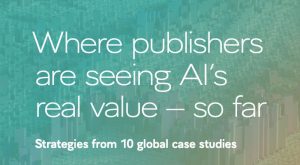WAN-IFRA’s 6th AI report reveals publishers’ perspective on value equation
AI is no longer just an experiment for publishers – it is becoming part of everyday operations. WAN-IFRA’s 6th AI report shows where the technology is delivering measurable value and where its impact remains harder to define.
 AI (artificial intelligence) continues to shape how publishers work, rapidly moving from pilot projects to practical applications in news publishing.
AI (artificial intelligence) continues to shape how publishers work, rapidly moving from pilot projects to practical applications in news publishing.
WAN-IFRA’s latest report titled ‘Where publishers are seeing AI’s real value – so far’, takes stock of that shift.
Based on a Q2 2025 survey of more than 100 media leaders and 10 detailed case studies, the report explores how publishers are applying AI to workflows, products and audience engagement – and where its value is proving hardest to measure.
The findings show that AI’s impact is strongest behind the scenes. While only 9 percent of publishers can point to direct revenue gains, 75 percent report efficiency improvements, 64 percent better content production, 55 percent faster publishing times, and 44 percent improved resource allocation.
In other words, AI is already changing how news is produced and delivered, even if the financial payoffs are still emerging.
“Revenue generation gets all the attention, but it’s often the wrong metric for AI in media. Cost reduction, quality improvements, speed gains, and better resource allocation deliver value faster and more measurably,” noted Ezra Eeman, Director of Strategy & Innovation at NPO, and Strategic Advisor for WAN-IFRA’s AI Initiatives.
The case studies
 Here is a summary of the case studies in the report (which was supported by our report partner, Stibo DX):
Here is a summary of the case studies in the report (which was supported by our report partner, Stibo DX):
The Hindu, India, Hard ROI: AI-driven recommendations for content, push notifications, and newsletters boosted CTRs, session durations, ad impressions and subscriptions.
Schibsted, Norway, Hard ROI: A machine learning model for real-time personalisation lifted front-page subscription sales by 75 percent, while scaling across multiple newsrooms.
United Daily News, Taiwan, Hard ROI: AI optimisation of ads, curation, and recommendations, drove 200 percent growth in ad performance, subscription conversions, and engagement.
Financial Times, UK, Soft ROI: FT’s Storyfinding team applies AI to surface patterns in large datasets, streamlining investigative workflows and supporting scalable newsroom tools.
NTM, Sweden, Hard and Soft ROI: Toppnyheter, an AI-powered audio news service, delivers real-time summaries while extending editorial oversight and audience reach.
La Nación, Argentina, Soft ROI: A custom AI pipeline analysed President Javier Milei’s speeches, structuring 739,961 words to track rhetorical patterns.
Legit.ng, Nigeria, Hard and Soft ROI: AI halved translation times, expanded Hausa-language coverage, boosted output, and improved fact-checking and distribution. “For us, AI is not about replacing journalists – it’s about giving them more time to do real journalism,” noted Rahaman Abiola, Editor-in-Chief.
Gannett, USA, Hard and Soft ROI: Gannett, the parent company of USA Today, is transforming its 200-plus publications into an AI-ready organisation by embedding the technology across workflows, training and tools. “The real risk isn’t AI replacing you. It’s someone using AI replacing you,” remarked Jessica Davis, Vice President of News Automation and AI Product at Gannett.
AsiaOne, Singapore, Hard ROI: An AI classification model improved ad targeting, boosted revenue by 20 percent, cut sales staff by 40 percent, and freed resources for higher-level strategy, while also providing shared insights across editorial, analytics and business teams.
South China Morning Post, Hong Kong, Hard ROI: AI summarisation, editing, translation, and investigative tools save 300+ hours monthly while enhancing accuracy and reach.


Comments are closed.